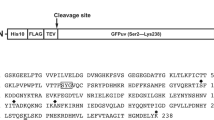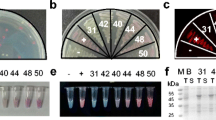Abstract
By thein vitro combinatorial mutagenesis, which is a sequential reaction of PCR mutagenesis andin vitro coupled transcription/translation withEscherichia coli S30 extract, S65 and E222 of green fluorescent protein ofAequarea victoria were comprehensively changed to all possible combinations of amino acids, thus totally 400 mutant (including a wild type) proteins were simultaneously produced and their fluorescent properties were analyzed. Although a few mutations had been reported so far at the 222nd position, replacement E222 to all other19 amino acids gave fluorescent signal to the mutants by changing Ser 65 to Ala together. Among the mutants, replacement to G, A, S, Q, H and C gave relatively high fluorescence. Thein vitro combinatorial mutagenesis, therefore, has been proved valuable for comprehensive structure-function studies of proteins.
Similar content being viewed by others
References
Burks, E. A., G. Chen, G. Georgiou, and B. L. Iverson (1997)In vitro scanning saturation mutagenesis of an antibody binding pocket.Proc. Natl. Acad. Sci. USA 94: 412–417.
Yang, J., Y. Koga, H. Nakano, and T. Yamane (2002) Modifying the chain-length selectivity of the lipase fromBurkholderia cepacia KWI-56 through in vitro combinatorial mutagenesis in the substrate binding site.Protein Eng. 15: 147–152.
Tsien, R. Y. (1998) Green fluorescent protein.Ann. Rev. Biochem. 67: 509–544.
Ohuchi, S., H. Nakano, and T. Yamane, (1998)In vitro method for the generation of protein libraries using PCR amplification of a single DNA molecule and coupled transcription/translation.Nucleic Acids Res. 26: 4339–4346.
Nakano, H., T. Shinbata, R. Okumura, S. Sekiguchi, M. Fujishiro, and T. Yamane (1999) Efficient coupled transcription/translation for PCR template by a hollow fiber membrane bioreactor.Biotechnol. Bioeng. 64: 194–199.
Ryabova, L. A., D. Desplancq, A. S. Spirin, and A. Plückthun (1997) Functional antibody production using cell-free translation: Effects of protein disulfide isomerase and chaperones.Nat. Biotechnol. 15: 79–84.
Jiang, X., Y. Ookubo, I. Fujii, H. Nakano, and T. Yamane (2002) Expression of Fab fragment of catalytic antibody 6D9 in anEscherichia coli in vitro coupled transcription/translation system.FEBS Lett. 514: 290–294.
Yang, J., K. Kobayashi, H. Nakano, J. Tanaka, T. Nihira, Y. Yamada, and T. Yamane (1999) Modulator-mediated synthesis of active lipase ofPseudomonas sp. 109 byEscherichia coli cell-free coupled transcription/translation system.J. Biosci. Bioeng. 88: 605–609.
Yang, J., K. Kobayashi, Y. Iwasaki, H Nakano and T. Yamane (2000)In vitro analysis of roles of a disulfide bridge and a calcium binding site in activation ofPseudomonas sp. strain KWI-56 lipase.J. Bacteriol. 182: 295–302.
Iwasaki, Y., T. Nishiyama, Y. Kawarasaki, H. Nakano, and T. Yamane (2000) Importance of disulfide bridge formation on folding of phospholipase D fromStreptomyces antibioticus.J. Biosci. Bioeng. 89: 506–508.
Jiang, X., H. Nakano, T. Kigawa, T. Yabuki, S. Yokoyama, D. S. Clark, and T. Yamane (2001) Dosage effect of minor arginyl- and isoleucyl-tRNA on protein synthesis in anE.coli in vitro coupled transcription/translation system.J. Biosci. Bioeng. 91: 53–57.
Jiang, X., K. Oohira, Y. Iwasaki, H. Nakano, S. Ichihara, and T. Yamane (2002) Reduction of protein degradation by use of protease-deficient mutants in cell-free protein synthesis system ofEscherichia coli.J. Biosci. Bioeng. 93: 136–144.
Nakano, H., K. Kobayashi, S. Ohuchi, S. Sekiguchi, and T. Yamane (2000) Single-step single-molecule PCR of DNA with a homo-priming sequence using a single primer and hotstartable DNA polymerase.J. Biosci. Bioeng. 90: 456–458.
Koga, Y., K. Kobayashi, J. Yang, H. Nakano, and T. Yamane (2002)In vitro construction and screening of aBurkholderia cepacia lipase library using single-molecule PCR and cell-free protein synthesis.J. Biosci. Bioeng. 94: 84–86.
Rungpragayphan, S., Y. Kawarasaki, T. Imaeda, K. Kohda, H. Nakano, and T. Yamane (2002) High-throughput, cloning-independent protein library construction by combining single-molecule DNA amplification within vitro expression.J. Mol. Biol. 318: 395–405.
Author information
Authors and Affiliations
Corresponding author
Rights and permissions
About this article
Cite this article
Nakano, H., Okumura, R., Goto, C. et al. In vitro combinatorial mutagenesis of the 65th and 222nd positions of the green fluorescent protein ofAequarea victoria . Biotechnol. Bioprocess Eng. 7, 311–315 (2002). https://doi.org/10.1007/BF02932841
Received:
Accepted:
Issue Date:
DOI: https://doi.org/10.1007/BF02932841




